Abstract
To develop a new approach to the treatment of advanced, hormone-refractory prostate cancer, the signal transductions regulating the growth of human androgen-independent prostate carcinoma cell lines were studied. Agonist-stimulated Ca2+ mobilization, a critical regulatory event in other secretory cell types, was studied as a means of identifying previously undescribed plasma membrane receptors that may transduce a growth inhibitory signal. In all of the cell lines tested, P2-purinergic receptor agonists, including ATP and certain hydrolysis-resistant adenine nucleotides, induced a rapid, transient increase in cytoplasmic free Ca2+ that was detectable at 50 to 100 nM ATP, was maximal at 100 microM ATP, and was inhibited approximately 50% by chelation of extracellular Ca2+. Within 8 s after addition, ATP stimulated accumulation of the polyphosphatidylinositol products inositol (1, 4, 5) trisphosphate, inositol (1, 3, 4) trisphosphate, and inositol tetrakisphosphate. In addition to stimulating phosphatidylinositol turnover and Ca2+ mobilization, ATP and hydrolysis-resistant ATP analogues induced greater than 90% inhibition of the growth of all lines tested. These data demonstrate that human androgen-independent prostate carcinoma cells express functional P2-purinergic receptors linked to phospholipase C, and that agonists of this receptor are markedly growth inhibitory, suggesting a novel therapeutic approach to this common adult neoplasm.
Full text
PDF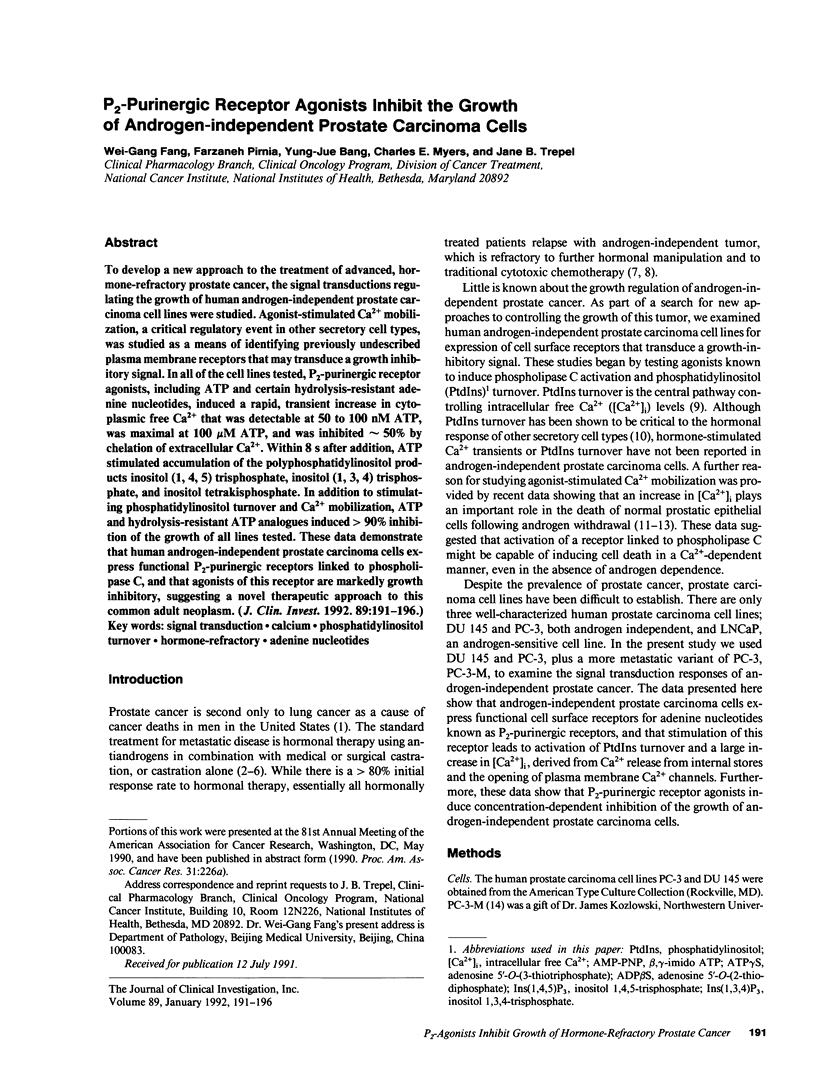
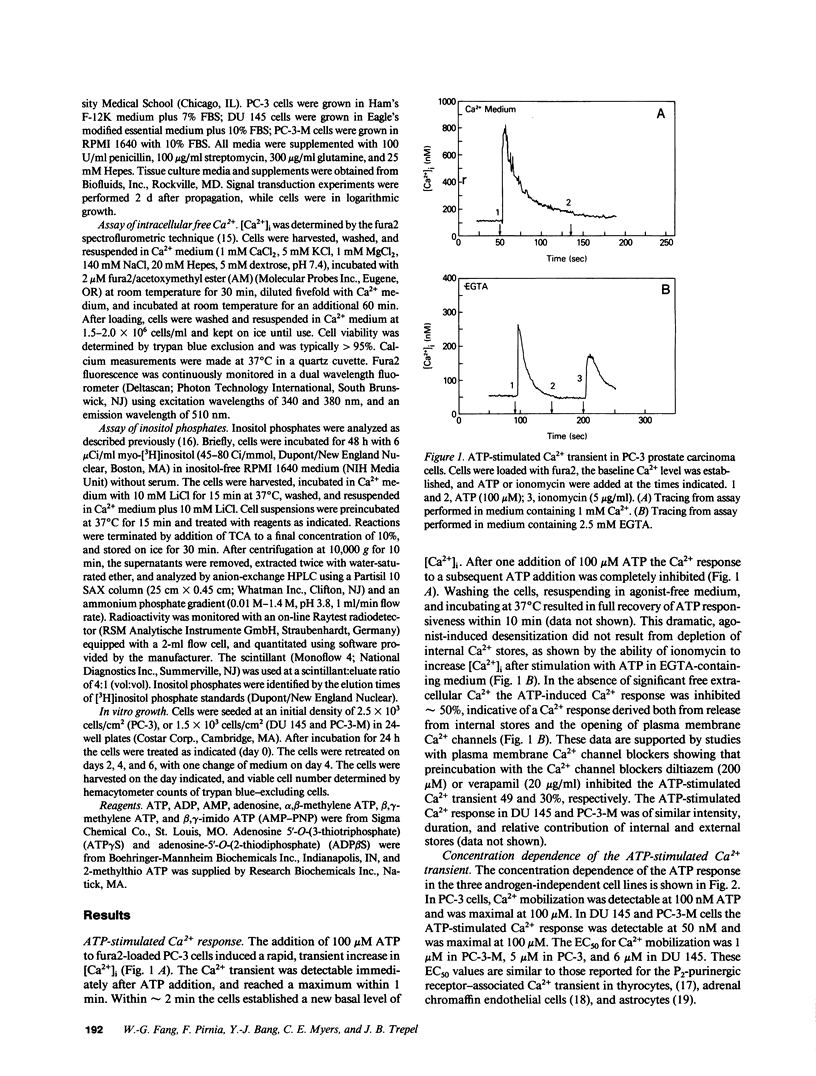
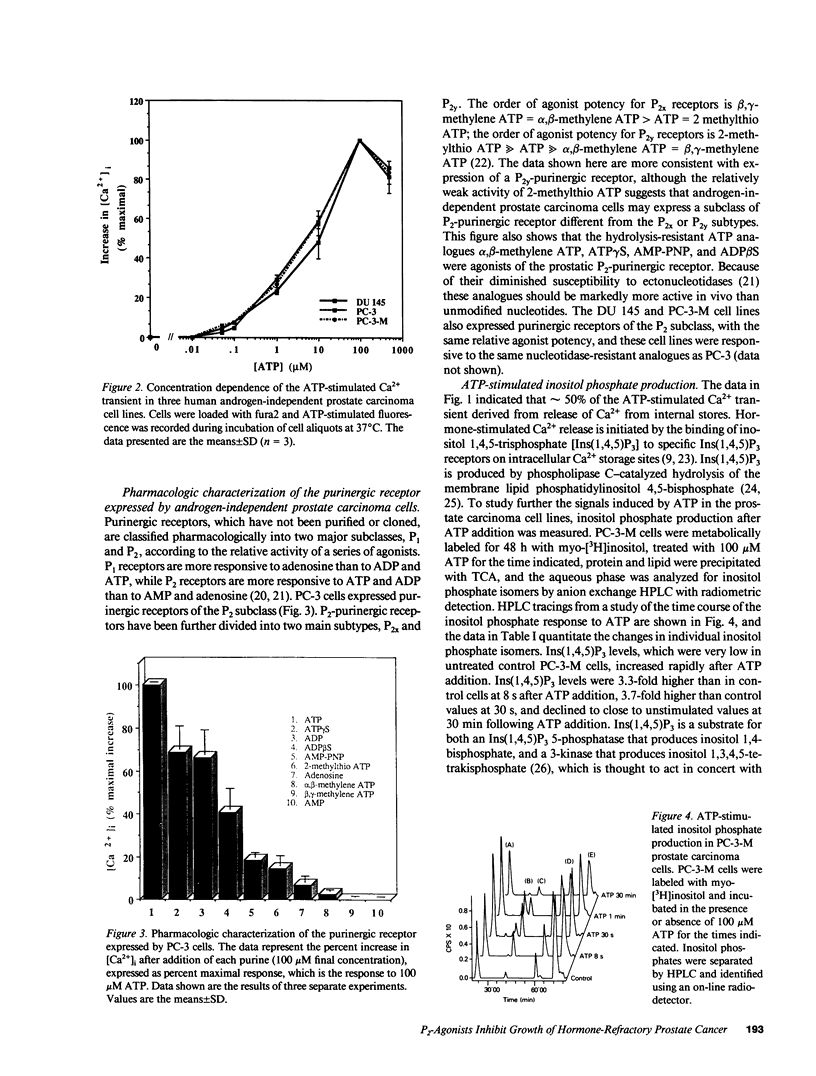
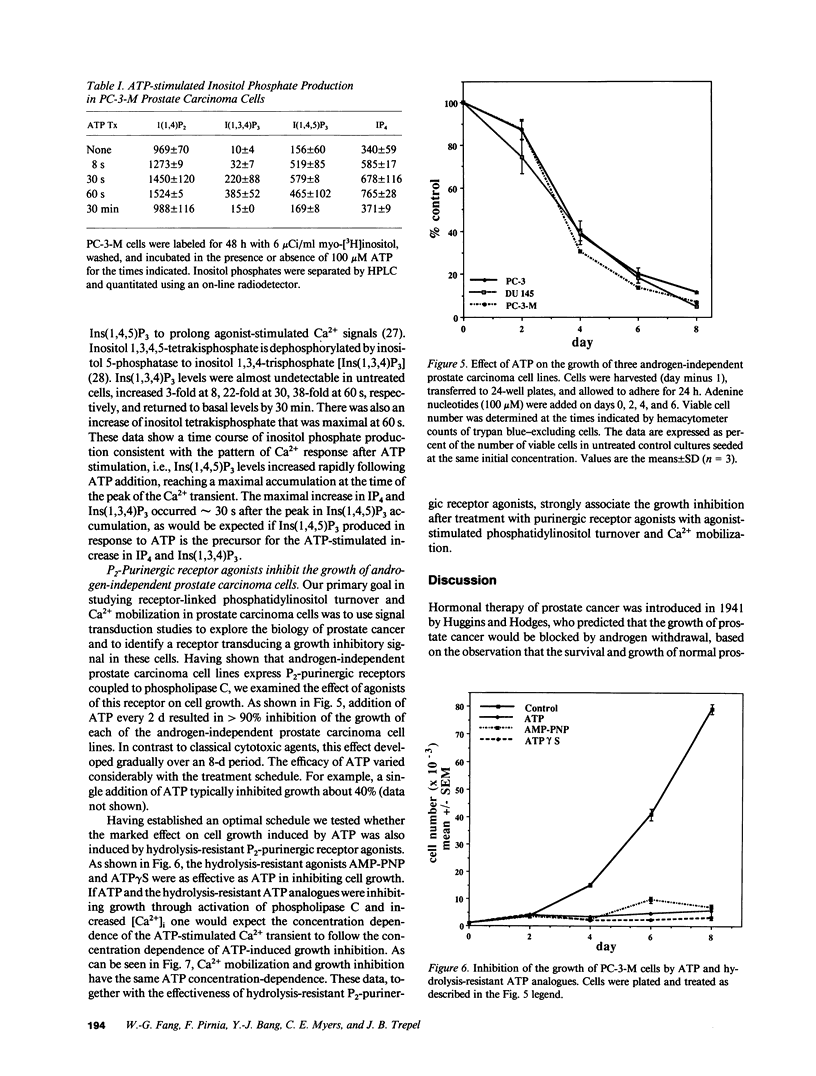
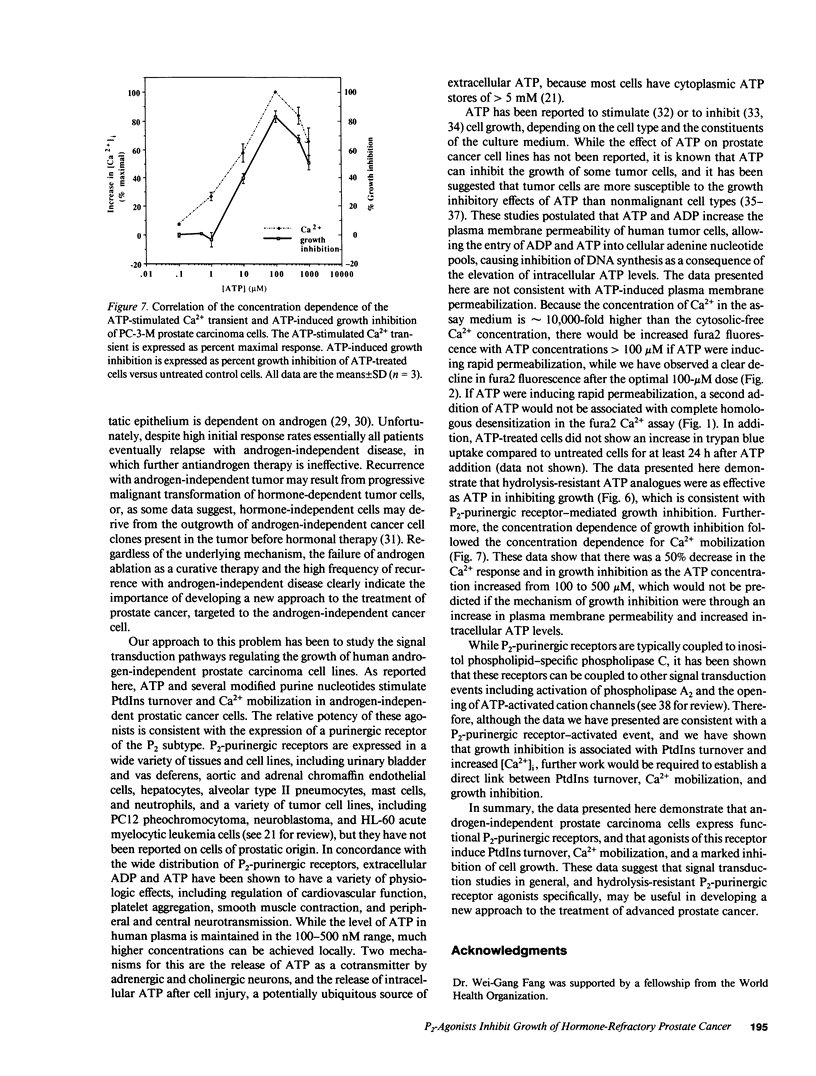
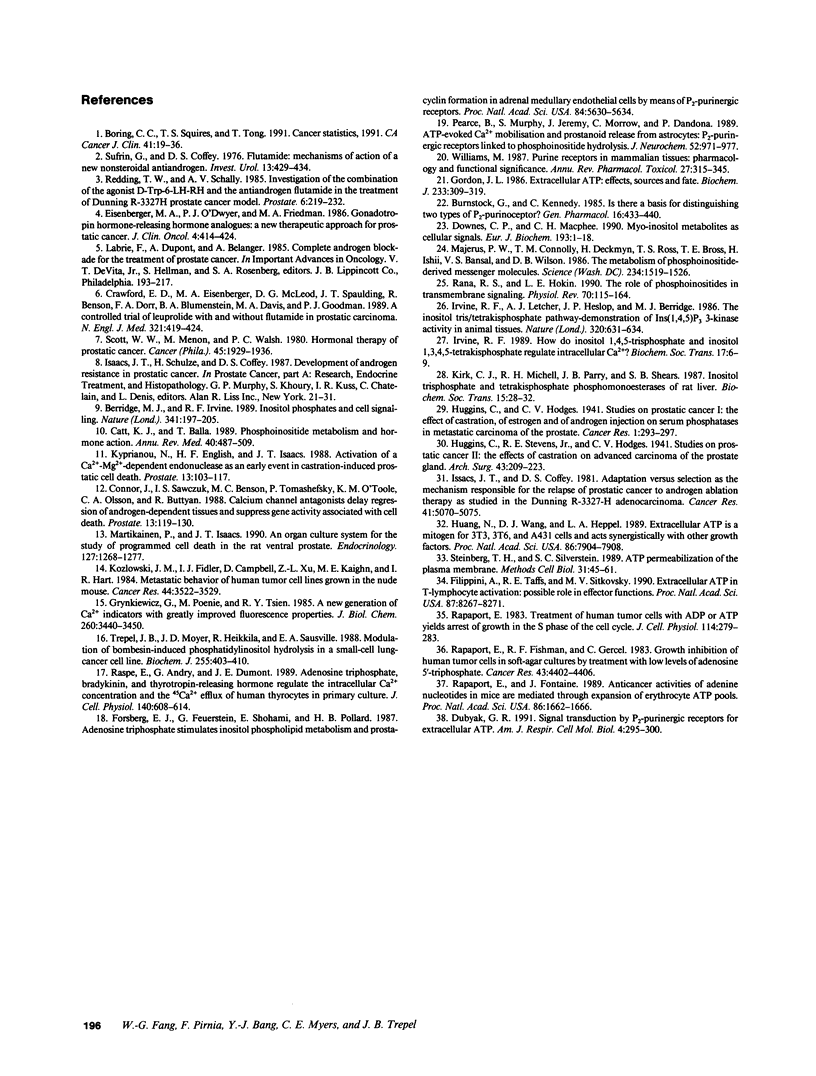
Images in this article
Selected References
These references are in PubMed. This may not be the complete list of references from this article.
- Berridge M. J., Irvine R. F. Inositol phosphates and cell signalling. Nature. 1989 Sep 21;341(6239):197–205. doi: 10.1038/341197a0. [DOI] [PubMed] [Google Scholar]
- Boring C. C., Squires T. S., Tong T. Cancer statistics, 1991. CA Cancer J Clin. 1991 Jan-Feb;41(1):19–36. doi: 10.3322/canjclin.41.1.19. [DOI] [PubMed] [Google Scholar]
- Burnstock G., Kennedy C. Is there a basis for distinguishing two types of P2-purinoceptor? Gen Pharmacol. 1985;16(5):433–440. doi: 10.1016/0306-3623(85)90001-1. [DOI] [PubMed] [Google Scholar]
- Catt K. J., Balla T. Phosphoinositide metabolism and hormone action. Annu Rev Med. 1989;40:487–509. doi: 10.1146/annurev.me.40.020189.002415. [DOI] [PubMed] [Google Scholar]
- Connor J., Sawczuk I. S., Benson M. C., Tomashefsky P., O'Toole K. M., Olsson C. A., Buttyan R. Calcium channel antagonists delay regression of androgen-dependent tissues and suppress gene activity associated with cell death. Prostate. 1988;13(2):119–130. doi: 10.1002/pros.2990130204. [DOI] [PubMed] [Google Scholar]
- Crawford E. D., Eisenberger M. A., McLeod D. G., Spaulding J. T., Benson R., Dorr F. A., Blumenstein B. A., Davis M. A., Goodman P. J. A controlled trial of leuprolide with and without flutamide in prostatic carcinoma. N Engl J Med. 1989 Aug 17;321(7):419–424. doi: 10.1056/NEJM198908173210702. [DOI] [PubMed] [Google Scholar]
- Downes C. P., Macphee C. H. myo-inositol metabolites as cellular signals. Eur J Biochem. 1990 Oct 5;193(1):1–18. doi: 10.1111/j.1432-1033.1990.tb19297.x. [DOI] [PubMed] [Google Scholar]
- Dubyak G. R. Signal transduction by P2-purinergic receptors for extracellular ATP. Am J Respir Cell Mol Biol. 1991 Apr;4(4):295–300. doi: 10.1165/ajrcmb/4.4.295. [DOI] [PubMed] [Google Scholar]
- Eisenberger M. A., O'Dwyer P. J., Friedman M. A. Gonadotropin hormone-releasing hormone analogues: a new therapeutic approach for prostatic carcinoma. J Clin Oncol. 1986 Mar;4(3):414–424. doi: 10.1200/JCO.1986.4.3.414. [DOI] [PubMed] [Google Scholar]
- Filippini A., Taffs R. E., Sitkovsky M. V. Extracellular ATP in T-lymphocyte activation: possible role in effector functions. Proc Natl Acad Sci U S A. 1990 Nov;87(21):8267–8271. doi: 10.1073/pnas.87.21.8267. [DOI] [PMC free article] [PubMed] [Google Scholar]
- Forsberg E. J., Feuerstein G., Shohami E., Pollard H. B. Adenosine triphosphate stimulates inositol phospholipid metabolism and prostacyclin formation in adrenal medullary endothelial cells by means of P2-purinergic receptors. Proc Natl Acad Sci U S A. 1987 Aug;84(16):5630–5634. doi: 10.1073/pnas.84.16.5630. [DOI] [PMC free article] [PubMed] [Google Scholar]
- Gordon J. L. Extracellular ATP: effects, sources and fate. Biochem J. 1986 Jan 15;233(2):309–319. doi: 10.1042/bj2330309. [DOI] [PMC free article] [PubMed] [Google Scholar]
- Grynkiewicz G., Poenie M., Tsien R. Y. A new generation of Ca2+ indicators with greatly improved fluorescence properties. J Biol Chem. 1985 Mar 25;260(6):3440–3450. [PubMed] [Google Scholar]
- Huang N., Wang D. J., Heppel L. A. Extracellular ATP is a mitogen for 3T3, 3T6, and A431 cells and acts synergistically with other growth factors. Proc Natl Acad Sci U S A. 1989 Oct;86(20):7904–7908. doi: 10.1073/pnas.86.20.7904. [DOI] [PMC free article] [PubMed] [Google Scholar]
- Irvine R. F. How do inositol 1,4,5-trisphosphate and inositol 1,3,4,5-tetrakisphosphate regulate intracellular Ca2+? Biochem Soc Trans. 1989 Feb;17(1):6–9. doi: 10.1042/bst0170006. [DOI] [PubMed] [Google Scholar]
- Irvine R. F., Letcher A. J., Heslop J. P., Berridge M. J. The inositol tris/tetrakisphosphate pathway--demonstration of Ins(1,4,5)P3 3-kinase activity in animal tissues. Nature. 1986 Apr 17;320(6063):631–634. doi: 10.1038/320631a0. [DOI] [PubMed] [Google Scholar]
- Isaacs J. T., Coffey D. S. Adaptation versus selection as the mechanism responsible for the relapse of prostatic cancer to androgen ablation therapy as studied in the Dunning R-3327-H adenocarcinoma. Cancer Res. 1981 Dec;41(12 Pt 1):5070–5075. [PubMed] [Google Scholar]
- Isaacs J. T., Schulze H., Coffey D. S. Development of androgen resistance in prostatic cancer. Prog Clin Biol Res. 1987;243A:21–31. [PubMed] [Google Scholar]
- Kirk C. J., Michell R. H., Parry J. B., Shears S. B. Inositol trisphosphate and tetrakisphosphate phosphomonoesterases of rat liver. Biochem Soc Trans. 1987 Feb;15(1):28–32. doi: 10.1042/bst0150028. [DOI] [PubMed] [Google Scholar]
- Kozlowski J. M., Fidler I. J., Campbell D., Xu Z. L., Kaighn M. E., Hart I. R. Metastatic behavior of human tumor cell lines grown in the nude mouse. Cancer Res. 1984 Aug;44(8):3522–3529. [PubMed] [Google Scholar]
- Kyprianou N., English H. F., Isaacs J. T. Activation of a Ca2+-Mg2+-dependent endonuclease as an early event in castration-induced prostatic cell death. Prostate. 1988;13(2):103–117. doi: 10.1002/pros.2990130203. [DOI] [PubMed] [Google Scholar]
- Labrie F., Dupont A., Belanger A. Complete androgen blockade for the treatment of prostate cancer. Important Adv Oncol. 1985:193–217. [PubMed] [Google Scholar]
- Majerus P. W., Connolly T. M., Deckmyn H., Ross T. S., Bross T. E., Ishii H., Bansal V. S., Wilson D. B. The metabolism of phosphoinositide-derived messenger molecules. Science. 1986 Dec 19;234(4783):1519–1526. doi: 10.1126/science.3024320. [DOI] [PubMed] [Google Scholar]
- Martikainen P., Isaacs J. T. An organ culture system for the study of programmed cell death in the rat ventral prostate. Endocrinology. 1990 Sep;127(3):1268–1277. doi: 10.1210/endo-127-3-1268. [DOI] [PubMed] [Google Scholar]
- Pearce B., Murphy S., Jeremy J., Morrow C., Dandona P. ATP-evoked Ca2+ mobilisation and prostanoid release from astrocytes: P2-purinergic receptors linked to phosphoinositide hydrolysis. J Neurochem. 1989 Mar;52(3):971–977. doi: 10.1111/j.1471-4159.1989.tb02549.x. [DOI] [PubMed] [Google Scholar]
- Rana R. S., Hokin L. E. Role of phosphoinositides in transmembrane signaling. Physiol Rev. 1990 Jan;70(1):115–164. doi: 10.1152/physrev.1990.70.1.115. [DOI] [PubMed] [Google Scholar]
- Rapaport E., Fishman R. F., Gercel C. Growth inhibition of human tumor cells in soft-agar cultures by treatment with low levels of adenosine 5'-triphosphate. Cancer Res. 1983 Sep;43(9):4402–4406. [PubMed] [Google Scholar]
- Rapaport E., Fontaine J. Anticancer activities of adenine nucleotides in mice are mediated through expansion of erythrocyte ATP pools. Proc Natl Acad Sci U S A. 1989 Mar;86(5):1662–1666. doi: 10.1073/pnas.86.5.1662. [DOI] [PMC free article] [PubMed] [Google Scholar]
- Rapaport E. Treatment of human tumor cells with ADP or ATP yields arrest of growth in the S phase of the cell cycle. J Cell Physiol. 1983 Mar;114(3):279–283. doi: 10.1002/jcp.1041140305. [DOI] [PubMed] [Google Scholar]
- Raspé E., Andry G., Dumont J. E. Adenosine triphosphate, bradykinin, and thyrotropin-releasing hormone regulate the intracellular Ca2+ concentration and the 45Ca2+ efflux of human thyrocytes in primary culture. J Cell Physiol. 1989 Sep;140(3):608–614. doi: 10.1002/jcp.1041400328. [DOI] [PubMed] [Google Scholar]
- Redding T. W., Schally A. V. Investigation of the combination of the agonist D-Trp-6-LH-RH and the antiandrogen flutamide in the treatment of Dunning R-3327H prostate cancer model. Prostate. 1985;6(3):219–232. doi: 10.1002/pros.2990060302. [DOI] [PubMed] [Google Scholar]
- Scott W. W., Menon M., Walsh P. C. Hormonal therapy of prostatic cancer. Cancer. 1980 Apr 15;45(7 Suppl):1929–1936. [PubMed] [Google Scholar]
- Steinberg T. H., Silverstein S. C. ATP permeabilization of the plasma membrane. Methods Cell Biol. 1989;31:45–61. doi: 10.1016/s0091-679x(08)61601-5. [DOI] [PubMed] [Google Scholar]
- Sufrin G., Coffey D. S. Flutamide. Mechanism of action of a new nonsteroidal antiandrogen. Invest Urol. 1976 May;13(6):429–434. [PubMed] [Google Scholar]
- Trepel J. B., Moyer J. D., Heikkila R., Sausville E. A. Modulation of bombesin-induced phosphatidylinositol hydrolysis in a small-cell lung-cancer cell line. Biochem J. 1988 Oct 15;255(2):403–410. doi: 10.1042/bj2550403. [DOI] [PMC free article] [PubMed] [Google Scholar]
- Williams M. Purine receptors in mammalian tissues: pharmacology and functional significance. Annu Rev Pharmacol Toxicol. 1987;27:315–345. doi: 10.1146/annurev.pa.27.040187.001531. [DOI] [PubMed] [Google Scholar]



